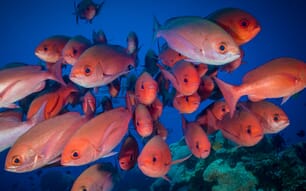Fiddler crabs (Uca stenodactylu) are sensitive to the polarization of light across the majority of their eyes, potentially allowing them to use polarization information for general visual tasks. However, investigations into this ability have largely been confined to laboratory settings under artificial lighting - until now.
Dr Martin How from Bristol's Ecology of Vision Group and colleagues studied wild populations of fiddler crabs on mudflats close to the Pacific entrance of the Panama Canal. A fiddler crab's body generates polarization contrast against the background which means that, when backlit by the sun, their claws and legs appear bright to any creature with polarization vision, including fellow members of the species.
The researchers tested whether male crabs living in and defending burrows responded to approaching targets on the mudflat over distances proportional to the polarization contrast of the target. The experimental 'target' was a weighted sled pulled along the mudflat towards the crab via a remotely operated pulley system. Attached to the sled was a piece of polymer retarder film capable of modifying transmitted polarized light to generate three different types of polarization.
The scientists found that male crabs responded to the approaching target as if it was a threat, such as another crab looking for a burrow or a predator. This response involved a sequence of typical defensive behaviours whereby the crab would first freeze, then quickly run back home to its burrow and assume a position of vigilance before descending into the burrow out of sight.
The 'freeze' response occurred over distances 24.2 per cent further away when the approaching target was vertically polarized compared to horizontally polarized.
Dr How said: "Our results show that these animals use their polarization vision to enhance contrast in their visual environment, thus increasing their ability to detect and respond to both fellow members of their species and ground-based predators.
"Our results provide one of the first pieces of evidence for a function of object-based polarization vision under natural lighting conditions."
Exactly how the polarization receptors in the crab's eye contribute to enhancing contrast, and hence detection, has yet to be demonstrated conclusively. However, there is evidence to suggest that intensity and polarization information conjoin early in visual processing to generate a single measure of contrast.
Future studies of this mechanism could lead to interesting technological applications in the field of digital image analysis, such as the development of contrast-enhancement algorithms for polarization cameras, the researchers said.




